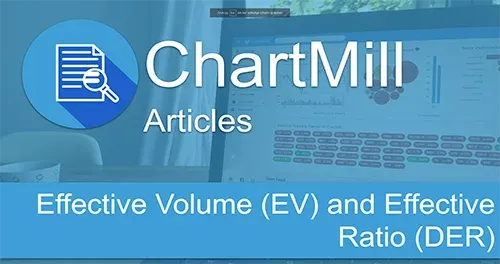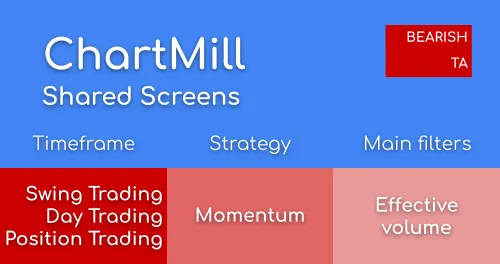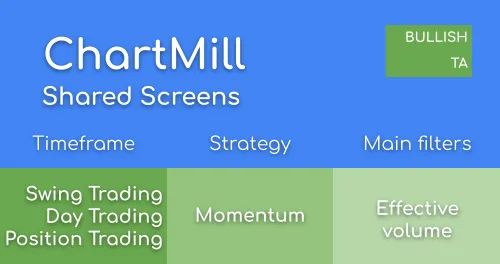Effective Volume (EV) and Effective Ratio (DER)
By Aldwin Keppens - reviewed by Dirk Vandycke
Last update: Apr 19, 2024
Effective Volume: introduction
Chartmills stock charts, stock screener and sector analysis tool support Effective Volume. Effective Volume was described in the book ‘Value in Time‘ by Pascal Willain. Pascal validated and approved our implementation.
For a thorough understanding of Effective Volume and its usage, we advise reading the book. We published a review of the book and a detailed description of Effective Volume in Traders Magazine. These articles can also be found in the 'related articles' section.
Effective Volume basically analyses the intraday volume on the minute level to determine what small and large players are doing in terms of accumulation and distribution. Interesting situations occur if the Large Effective Volume trend diverges from the price trend.
Effective Volume is often misunderstood. Lets start with a quote from Pascal Willain, the inventor of EV:
Because EV goes up and down, and because it is based on volume, then the mistake is to believe that it represents a "force" of action. However, it only represents a disequilibrium in the "liquidity trading" activity of large investors.
Before decimalization, it was important to keep orders on the order book. After decimalization, it has become important to place orders as soon as liquidity was detected. This means that today's market is a liquidity fight: action/reaction. Algos want to trigger levels, stops and boost liquidity in order to place their trade and be able to move volume.
When there is an important trend or a big price move, you will almost always see EV move on the opposite side, because funds use the available liquidity to adjust their position. In such conditions, EV is almost useless and even misleading.
EV needs to be used when price equilibrium is back in the markets:
- After a price move, when the stock enter into a base, EV will indicate the probable next price move.
- On a support/resistance line, EV might indicate how the stock will act: break the line or revert back.
Effective Volume interpretation and usage
We will make a couple of more points on Effective Volume and its interpretation:
- Inside chartmill, it is best to only display the Large Effective Volume line (the red line). This is because both LEV and SEV are accumulated from their starting point, which may be years back. Because of this, the lines may be in totally different absolute area's and will appear rather flat. Only displaying the red line paints a clear picture of the Large Effective Volume, which is what we are interested in.
- When the red line goes up, we say 'large players are buying', while it would be more correct to say: 'we have more large players buying than we have large players selling', or even more correct: 'the total volume bought by large players was more than the total volume sold by large players'.
- Because of how EV is calculated, the normal situation is that EV follows price. This is also the least interesting situation and should not be seen as large players supporting the move.
- More interesting situations are when we have a divergence, when EV does not follow price:
- Inside base formations, when prices are nearly flat, EV will give a good indication of what large players are doing. This is definitely the most interesting EV use case.
- Price goes up or down and EV goes the other direction. Although this does indicate that large players are selling strength or buying weakness, it does not necessarily mean that price will revert. Large players are using the increased liquidity to adjust their positions, but the last thing they want is price to revert while they are doing what they need to do. As goes for any technical setup: it is always best to wait for the reversal to actually take place before you consider a position.
- When looking at Large Players Effective Volume, we typically look at what is happening in the last couple of days. Historical values for EV have little value. We want to know what large funds are doing at this moment or in the last couple of days.
- Large players buying or selling are no guarantee that price will follow. Large players also make wrong choices. I believe it was Pascal himself who mentioned something like: "Large players don't always have it right, but I rather have them supporting my view than going in against them" in his book.
- Absolute values of the LEV line are of no value at all. Again, since LEV is accumulated each day, the region in which it is displayed today depends on the historical values.
Effective Volume on the stock charts
In our stock charts, the following Effective Volume indicators are present:
- Effective Volume: S/L Players: shows the action of Small and Large players.
- Effective Volume: S/L/A Players: shows the action of Small, Large and All players.
- Effective Volume: All Players: shows the action of All players
- Effective Volume: Large Players: shows the action of Large players.
Effective Volume Stock Screener
Our stock screener allows you to filter on the properties of the Large Players Effective Volume. On the indicators tab, there is a field named Effective Volume which allows filtering based on its 10 and 20 Large Effective Volume daily moving average. ( E.g: value above rising 10 DMA ).
The same filter field also has filters related to the Daily Effective Ration (DER), which is discussed below. Some example screens can be found in the related screens section next to this article.
You can find more details on practical usage of the EV indicator in this article.
Effective Ratio
In his book, Pascal defines the Effective Ratio as the total Effective Volume by Large Players divided by the total volume. This results in the percentage of volume that was accumulated or distributed by large players in a specific stock.
We use the effective ratio in our stock screener:
- The indicators tab has a field named **Effective Volume**. Here you can filter on the 1, 3 or 5 average daily effective ratio. If you select for instance '3DER > 5%', it will filter all stocks where the Daily Effective Ratio was over 5% on average in the last 3 days.
- Stocks can also be sorted according to their 3 or 5 average daily effective ratio percentage. If you sort stocks on a descending 5DER, you will get stocks showing the strongest accumulation in the last 5 days on top.
- Also the 10 and 20 day DER variables are available for display in custom views and can be used in custom expressions in the screener.
3 and 5 Daily Effective Ratio in our sector analysis tool
The sector analysis tool has 3DER and 5DER columns. This shows the average 3 or 5 Daily Effective Ratio of all stocks in the industry or sector. The tools allows sorting the sectors by 3 or 5 DER. Sorting them will show you which sectors or industries show the strongest accumulation or distribution by large players.









